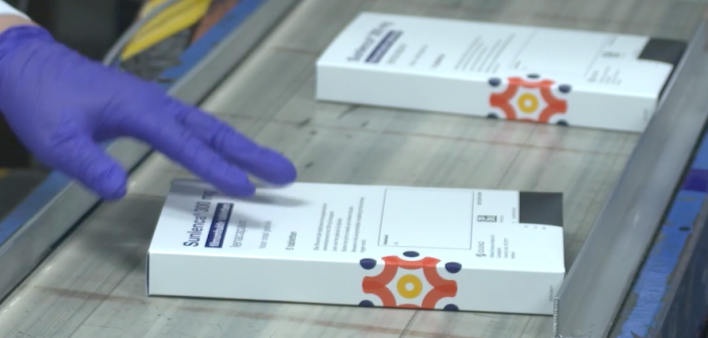On December 22, the Food and Drug Administration (FDA) approved Sunlenca (lenacapavir) as a new option for treatment-experienced people with multidrug-resistant HIV who are unable to maintain viral suppression on their current antiretroviral regimen. Sunlenca is also approved in the United Kingdom, Europe and Canada. The approval does not include first-time HIV treatment or pre-exposure prophylaxis (PrEP), though Sunlenca is being studied for these indications.
Administered every six months, Sunlenca is the longest-acting HIV medication. The FDA approval covers injectable Sunlenca and a tablet formulation. The tablets are taken first, as a loading dose, followed by subcutaneous injections every six months.
“Today’s approval ushers in a new class of antiretroviral drugs that may help patients with HIV who have run out of treatment options,” Debra Birnkrant, MD, director of the Division of Antivirals in the FDA’s Center for Drug Evaluation and Research, said in a press release. “The availability of new classes of antiretroviral medications may possibly help these patients live longer, healthier lives.”
Today, the U.S. FDA approved our first-in-class #HIV treatment option administered twice-yearly for people with limited therapy choices. https://t.co/FHnFj2xNk9 pic.twitter.com/sH2NF1zLav
— Gilead Sciences (@GileadSciences) December 22, 2022
Sunlenca (formerly GS-6207), the first approved HIV capsid inhibitor, disrupts the cone-shaped shell that surrounds the viral genetic material and essential enzymes. Laboratory studies showed that it interferes with multiple stages of the HIV life cycle. Because it works differently than existing medications, it remains active against HIV that has developed resistance to other antiretrovirals. The drug has a long half-life in the body, allowing it to be administered just once every six months.
Sunlenca is indicated for the treatment of HIV in heavily treatment-experienced adults with multidrug-resistant virus whose current antiretroviral regimen is failing due to resistance, intolerance or safety considerations. This group includes long-term survivors who used early HIV meds, sometimes one at a time or in suboptimal combinations. Such individuals may rely on complex regimens with multiple drugs that are still not fully suppressive.
The approval is supported by data from the Phase II/III CAPELLA trial (NCT04150068). The study included 72 treatment-experienced people with highly resistant HIV who were currently on antiretroviral therapy but unable to maintain viral suppression. Nearly two thirds had advanced immune suppression.
In the first cohort, 36 participants were randomly assigned to add either Sunlenca or placebo pills to their failing regimen for 14 days. At that point, everyone was offered Sunlenca injections every six months plus an optimized background regimen. Another 36 people in a nonrandomized open-label cohort all started on oral Sunlenca plus an optimized background regimen, followed by twice-yearly Sunlenca injections.
At this year’s Conference on Retroviruses and Opportunistic Infections, researchers reported that 83% of participants in the randomized cohort had an undetectable viral load (below 50) after 52 weeks of treatment. The mean CD4 increase was 82 cells, and the proportion of people with an adequate level (200 or higher) rose from 25% to 60%.
At the recent HIV Drug Therapy meeting in Glasgow, researchers presented data on the effectiveness of Sunlenca in different subgroups. Men and women, older and younger people, and people of different racial and ethnic groups all had good responses. The response rate was highest (94%) for people with two or more active agents in their optimized background regimen, falling to 67% for those with no fully active agents—still quite impressive for people with such highly resistant HIV. People with a baseline CD4 count below 200—those in greatest need of effective treatment—had a response rate of 78%.
Sunlenca is safe and well tolerated, and no drug-related serious adverse events were observed in the trial. The most common side effect is injection site reactions, such as pain, redness or swelling, mostly mild to moderate. However, some people may experience persistent nodules at the injection site. Sunlenca can remain in the body at a low level for a year or longer, meaning people who stop the drug or miss doses could develop resistance.
“The availability of new classes of antiretroviral drugs is critical for heavily treatment-experienced people with multi-drug resistant HIV,” CAPELLA investigator Sorana Segal-Maurer, MD, of Weill Cornell Medicine said in a Gilead press release. “Following today’s decision from the FDA, lenacapavir helps to fill a critical unmet need for people with complex prior treatment histories and offers physicians a long-awaited twice-yearly option for these patients who otherwise have limited therapy choices.”
Sunlenca injections and tablets are expected to cost $42,250 for the first year of treatment and $39,000 per year thereafter, according to Reuters.
The long-awaited approval comes after a delay as Gilead resolved manufacturing issues. Late last year, the company announced that the FDA had put a clinical hold on Sunlenca trials due to concerns about the glass vials used for the injectable formulation. But in May, the FDA lifted the hold and allowed trials to resume after Gilead presented a plan to switch to a different type of glass.
Importantly, Sunlenca must be used in combination with other antiretrovirals. At this time, no other HIV drugs can be taken as seldom as every six months, so it is not yet possible to construct a complete twice-yearly regimen. However, Gilead and other companies are exploring new long-acting agents, including broadly neutralizing antibodies. Before today, the longest-acting HIV treatment was ViiV Healthcare’s Cabenuva (injectable cabotegravir and rilpivirine), which can be administered every one or two months.
While HIV treatment requires combination therapy to prevent the development of drug resistance, a single drug may be adequate for HIV prevention. Sunlenca is currently being tested as PrEP, with promising results so far. Currently, the longest-acting PrEP option is ViiV’s Apretude (injectable cabotegravir alone), which is administered every other month.
Click here for more news about long-acting HIV treatment.







Comments
Comments